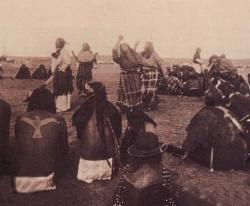The Ghost Dance and Wounded Knee Massacre
 By the late 1880s, many Indian tribes, desperate and facing a dire existence of poverty, hunger and disease, sought a means of salvation to revitalize their traditional culture. The evolution of a new religion, the Ghost Dance, was a reaction to the Indians being forced to submit to government authority and reservation life. In early 1889, a Paiute shaman, Wovoka, (son of the mystic, Tavibo, whose teachings influenced the new religion) had a vision during an eclipse of the sun in which he saw the second coming of Christ and received a warning about the evils of the white man.
By the late 1880s, many Indian tribes, desperate and facing a dire existence of poverty, hunger and disease, sought a means of salvation to revitalize their traditional culture. The evolution of a new religion, the Ghost Dance, was a reaction to the Indians being forced to submit to government authority and reservation life. In early 1889, a Paiute shaman, Wovoka, (son of the mystic, Tavibo, whose teachings influenced the new religion) had a vision during an eclipse of the sun in which he saw the second coming of Christ and received a warning about the evils of the white man.Knowledge of the vision spread quickly through the Indian camps across the country. Word began to circulate among the people on the reservations that a great new Indian Messiah had come to liberate them, and investigative parties were sent out to discover the nature of these claims. On one of the excursions, it is said that the messiah appeared to an Arapaho hunting party, crowned with thorns. They believed him to be the incarnation of Jesus, returned to save the Indian nations from the scourge of white people. Delegations were sent to visit Wovoka in western Nevada and returned to their camps disciples, preaching a new religion that promised renewal and revitalization of the Indian nations. Among those who met with Wovoka, Good Thunder, Short Bull, and Kicking Bear became prominent leaders of the new religion which was called the Ghost Dance by white people because of its precepts of resurrection and reunion with the dead.
According to Wovoka, converts of the new religion were supposed to take part in the Ghost Dance to hasten the arrival of the new era as promised by the messiah. Although the Bureau of Indian Affairs banned the Ghost Dance (as they did all other Indians spiritual rituals), the Lakotas adopted it and began composing sacred songs of hope\;
The whole world is coming,
A nation is coming, a nation is coming,
The eagle has brought the message to the tribe.
The Father says so, the Father says so.
Over the whole earth they are coming,
The buffalo are coming, the buffalo are coming,
The crow has brought the message to the tribe,
The Father says so, the Father says so.
The Ghost Dance religion promised an apocalypse in the coming years during which time the earth would be destroyed, only to be recreated with the Indians as the inheritors of the new earth. According to the prophecy, the recent times of suffering for Indians had been brought about by their sins, but now they had withstood enough under the whites. With the earth destroyed, white people would be obliterated, buried under the new soil of the spring that would cover the land and restore the prairie. The buffalo and antelope would return, and deceased ancestors would rise to once again roam the earth, now free of violence, starvation, and disease. The natural world would be restored, and the land once again would be free and open to the Indian peoples, without the borders and boundaries of the white man. The new doctrine taught that salvation would be achieved when the Indians purged themselves of the evil ways learned from the white man, especially the drinking of alcohol. Believers were encouraged to engage in frequent ceremonial cleansing, meditation, prayer, chanting, and most importantly, dancing the Ghost Dance. Hearing rumors of the prophecy and fearing that it was a portent of renewed violence, white homesteaders panicked and the government responded.
The government agent at Standing Rock, James McLaughlin, described the Ghost Dance as an "absurd craze" - "demoralizing, indecent, disgusting." Reservation agents described the Indians as "wild and crazy," and believed that their actions warranted military protection for white settlers. But while one of the primary goals of the Bureau of Indian Affairs was to convert the Indians to Christianity, they did not recognize that the fundamental principles of the Ghost Dance were indeed Christian in nature and had the effect of converting many to a belief in the one Christian God. In addition, Wovoka preached that, to survive, the Indians needed to turn to farming and to send their children to school to be educated. Ironically, while these efforts would appear to coincide with the goals of the Bureau, the Ghost Dance was outlawed by the agency. The Bureau feared the swelling numbers of Ghost Dancers and believed that the ritual was a precursor to renewed Indian militancy and violent rebellion. Source
White officials became alarmed at the religious fervor and activism and in December 1890 banned the Ghost Dance on Lakota reservations. When the rites continued, officials called in troops to Pine Ridge and Rosebud reservations in South Dakota. The military, led by veteran General Nelson Miles, geared itself for another campaign.
The presence of the troops exacerbated the situation. Short Bull and Kicking Bear led their followers to the northwest corner of the Pine Ridge reservation, to a sheltered escarpment known as the Stronghold. The dancers sent word to Sitting Bull of the Hunkpapas to join them. Before he could set out from the Standing Rock reservation in North Dakota, however, he was arrested by Indian police. A scuffle ensued in which Sitting Bull and seven of his warriors were slain. Six of the policemen were killed.

General Miles had also ordered the arrest of Big Foot, who had been known to live along the Cheyenne River in South Dakota. But, Big Foot and his followers had already departed south to Pine Ridge, asked there by Red Cloud and other supporters of the whites, in an effort to bring tranquility. Miles sent out the infamous Seventh Calvary led by Major Whitside to locate the renegades. They scoured the Badlands and finally found the Miniconjou dancers on Porcupine Creek, 30 miles east of Pine Ridge. The Indians offered no resistance. Big Foot, ill with pneumonia, rode in a wagon. The soldiers ordered the Indians to set up camp five miles westward, at Wounded Knee Creek. Colonel James Forsyth arrived to take command and ordered his guards to place four Hotchkiss cannons in position around the camp. The soldiers now numbered around 500; the Indians 350, all but 120 of these women and children.
 The following morning, December 29, 1890, the soldiers entered the camp demanding the all Indian firearms be elinquished. A medicine man named Yellow Bird advocated resistance, claiming the Ghost Shirts would protect them. One of the soldiers tried to disarm a deaf Indian named Black Coyote. A scuffle ensued and the firearm discharged. The silence of the morning was broken and soon other guns echoed in the river bed. At first, the struggle was fought at close quarters, but when the Indians ran to take cover, the Hotchkiss artillery opened up on them, cutting down men, women, children alike, the sick Big Foot among them [Big Foot lies dead picture Above]. By the end of this brutal, unnecessary violence, which lasted less than an hour, at least 150 Indians had been killed and 50 wounded. In comparison, army casualties were 25 killed and 39 wounded. Forsyth was later charged with killing the innocents, but exonerated. Source
The following morning, December 29, 1890, the soldiers entered the camp demanding the all Indian firearms be elinquished. A medicine man named Yellow Bird advocated resistance, claiming the Ghost Shirts would protect them. One of the soldiers tried to disarm a deaf Indian named Black Coyote. A scuffle ensued and the firearm discharged. The silence of the morning was broken and soon other guns echoed in the river bed. At first, the struggle was fought at close quarters, but when the Indians ran to take cover, the Hotchkiss artillery opened up on them, cutting down men, women, children alike, the sick Big Foot among them [Big Foot lies dead picture Above]. By the end of this brutal, unnecessary violence, which lasted less than an hour, at least 150 Indians had been killed and 50 wounded. In comparison, army casualties were 25 killed and 39 wounded. Forsyth was later charged with killing the innocents, but exonerated. Sourcedb: This post was prompted by www.villageearth.org and specifically references to Ghost Dance and Wounded Knee massacre in this article by Juan Espinosa.
- See below photograph of London same year as above - 1890 - a view looking up Farringdon Street towards Holborn Viaduct, EC 1.







<< Home